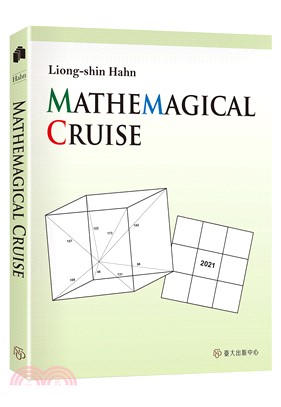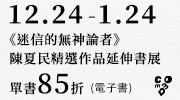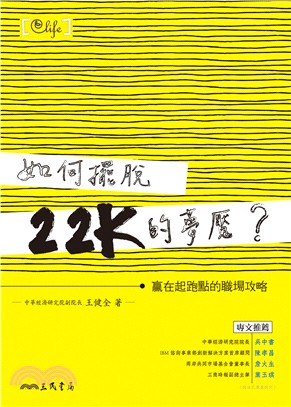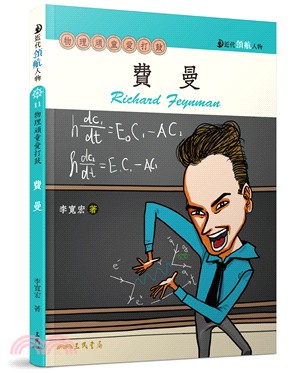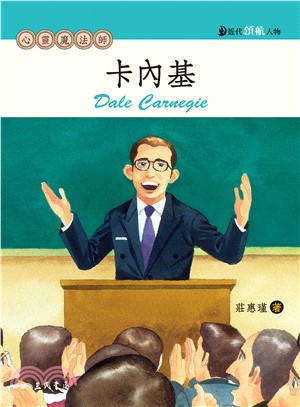Mathemagical Cruise
商品資訊
系列名:教科書
ISBN13:9789863507543
出版社:臺大出版中心
作者:Liong-shin Hahn(韓良信)
出版日:2023/08/17
裝訂/頁數:平裝/248頁
規格:21cm*17cm*1.3cm (高/寬/厚)
重量:500克
版次:初
商品簡介
Mathemagical Cruise is not a mere collection of fun problems with clever solutions. It offers shining examples of how to approach problem solving.
Each chapter is independent and can be read in any order by everyone with a basic background in high school mathematics. Some highlights of the excursion are:
● Slick Solutions of Double Sequence, Klarner’s Puzzle, Cube Tour, etc.
● Easy Proofs of Bolyai-Gerwin Theorem, Problem by P. Erdös and more
● New Year Puzzles (Especially, Year 2021 & 2022)
● Twelve Points on the Nine-Point Circle
● What's a Point in a Square?
● Five Circles through a 5x6 Grid
● Generalization of Ceva's Theorem
● Easy Approach to Coaxal Circles
● Inversion and its Applications
● Lattice Integer Triangles
● Isbell's Problem
● Sequence of Theorems of Simson & Cantor
● Miscellaneous Problems with Solutions
By cruising through these treasure islands, the reader will traverse mathematical boundaries. Be adventurous and inspired to explore the seas beyond the horizon.
作者簡介
Liong-shin Hahn was born in Tainan, Taiwan. After graduating from the Tainan First Middle School and the National Taiwan University, he attended Stanford University and obtained his Ph.D. under Professor Karel deLeeuw. He authored Complex Numbers and Geometry (Mathematical Association of America, 1994), New Mexico Mathematics Contest Problem Book (University of New Mexico Press, 2005),
Honsberger Revisited (National Taiwan University Press, 2012), Mathemagical Buffet (National Taiwan University Press, 2013), and co-authored with Bernard Epstein Classical Complex Analysis (Jones and Bartlett, 1996). He was awarded the Citation for Public Service from the American Mathematical Society in 1998. His number one hobby is creating/solving mathematical puzzles.
序
Preface
Denken Sie nach! (Ferdinand Georg Frobenius)
After I published my last book, Mathemagical Buffet, in January 2013, I had absolutely no plan to write another book. Still I enjoyed solving or creating puzzles because that was my most enjoyable leisure activity. Whenever I found interesting problems, I would try to solve them without reading the answers—even if it took me days or weeks. And I tried routinely to improve these problems to make them more interesting or more challenging. Before I realized it, I had accumulated piles of lovely results and I felt it was a pity not to share them with others. That is how this book came into being.
Over the years, I developed a habit of reading proofs or solutions only after I proved or solved them myself. I obtain a deeper understanding by comparing and analyzing the different proofs and solutions. And when my proof or solution is simpler, more elementary, or more natural than the published ones, it becomes material for my book. In fact, this is the way I wrote my last few books, including this one. To me this is the most enjoyable way to read math books.
Ever since I was a young boy I admired people who could find concise and lean solutions. But at the same time, I was often frustrated that I could not find any clues to their thought processes that led to those wonderful insights. How I wished authors would be kind enough to explain the fine details leading to their brilliant solutions! Consider the following well-known puzzle:
Anyone can cut a 3 × 3 × 3 cube of tofu into 27 unit cubes with six cuts. But suppose you are allowed to re-arrange the pieces between the cuts—what is the minimum number of cuts to do the job?
It is nice to impress people with an elegant answer. However, as a teacher, I think it is also educational to suggest similar but easier cases that lead to the solution. For example, if students have no clue how to tackle this puzzle, then why not suggest that they try the 2-dimensional (or even 1-dimensional) version first?
Thus, in writing I always hold on to the feeling of my youth. I hope readers will enjoy exploring the places my cruise could not reach. Bon Voyage!
目次
Preface
1 Puzzles
1.1 Parity
1.2 Double Sequences
1.3 15-Puzzle
1.4 Klarner’s Puzzle
1.5 A Cube Tour
1.6 Safe Cracking
1.7 Tilings
1.8 A ProblemonWeighted Trees
2 The Bolyai-Gerwin Theorem
2.1 Baby Pythagoras
2.2 A Triangular Carpet
2.3 The Bolyai-Gerwin Theorem
3 New Year Puzzles
3.1 New Year Puzzle 2014
3.2 New Year Puzzle 2015
3.3 Heron’s Formula Revisited
3.4 New Year Puzzle 2016
3.5 New Year Puzzle 2017
3.6 New Year Puzzle 2018
3.7 New Year Puzzle 2019
3.8 New Year Puzzle 2020
3.9 New Year Puzzle 2021
3.10 New Year Puzzle 2022
3.11 New Year Puzzle 2023
3.12 New Year Puzzle 2024
3.13 New Year Puzzle 2025
4 In Remembrance of Professor Ross Honsberger
4.1 The Bulging Semicircle
4.2 The Last Digits of 79999
4.3 A Diophantine Equation
4.4 Sumof the Digits
4.5 Gaps between Consecutive Primes
4.6 Triangle Numbers That Are Perfect Squares
4.7 A Problemby Erdӧs
5 Triangles
5.1 Medians
5.2 Orthocenter and Circumcenter
5.3 Incenter and Excenters
6 From the Desks of My Friends
6.1 FromDean Ballard
6.1.1 What’s a Point in a Square?
6.1.2 Wythoff’s Game
6.1.3 The Game of Nim
6.2 From Tien-Sheng Hsu
7 How Many Interior Right Angles Can a Polygon Have?
8 Ceva and Menelaus Revisited
9 Circles
9.1 Preliminaries
9.2 Radical Axes
9.3 Coaxal Circles
9.4 Inversion
9.5 Theorems of Ptolemy, Steiner and Poncelet
9.6 An Old Japanese Theorem
9.7 With Coordinates
10 Lattice Points
10.1 The Schinzel Theorem
10.2 Lattice Integer Triangles
10.3 The Isbell Problem
11 On the Theorems of Simson and of Cantor
Appendix A Problems
Appendix B Solutions and Hints
主題書展
更多書展今日66折
您曾經瀏覽過的商品
購物須知
為了保護您的權益,「三民網路書店」提供會員七日商品鑑賞期(收到商品為起始日)。
若要辦理退貨,請在商品鑑賞期內寄回,且商品必須是全新狀態與完整包裝(商品、附件、發票、隨貨贈品等)否則恕不接受退貨。



